Exam C1000-083: Foundations of IBM Cloud V2
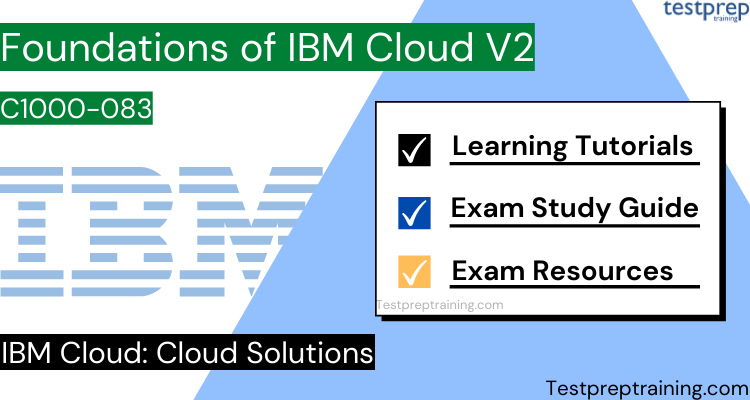
The C1000-083 Foundations Of IBM Cloud V2 Exam is designed to help candidates become an IBM Certified Solution Advisor – IBM Cloud Foundations. IBM Certified Solution Advisor is an individual who is responsible for engaging with clients looking for selecting and designing a solution based on IBM Cloud. However, Solution Advisor can come from a sales professional, architect, consultant, or developer background.
Learning Objectives
While preparing for the Foundation of IBM Cloud V2 (C1000-083) exam, IBM gives candidates access to various courses that include learning objectives. Using these candidates will be able to gain various skills and perform tasks. Some of the tasks that candidates will be able to do after completing this course include:
- Defining cloud computing and explaining its essential characteristics, history, & emerging trends
- Articulating the business case for cloud computing
- Describing the service & deployment models of cloud computing
- Explaining the various components of a cloud architecture
- Accessing the IBM Cloud using graphical interfaces, command-line tools, and the API
- Discovering appropriate IBM Cloud products or services available to deliver specific functionality
IBM C1000-083:Exam Details
Foundation of IBM Cloud V2 (C1000-083) exam consists of 60 questions. Candidates will get a maximum of 90 minutes to complete the IBM C1000-083 Questions. However, to pass the exam, candidates are required to give 43 correct answers. The IBM C1000-083 Exam Questions are available in English and it will cost you around $200 USD.
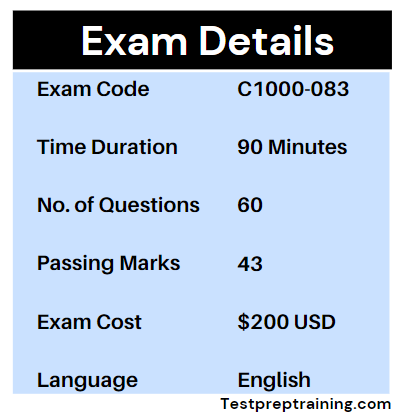
Exam Scheduling
Candidates can schedule the Foundation of IBM Cloud V2 (C1000-083) exam by using the below steps:
- First, create an account on the IBM landing page of the Pearson VUE website. There you have to provide your email address and basic demographic information (such as name, address, phone number).
- Then, Go to the IBM landing page and Sign-in to your account.
- After that, choose your exam and select a testing location. It will ask for a schedule, date & time for testing.
- Lastly, complete the payment process. Then, Pearson VUE will email detailed instructions for taking your exam. The email will include directions, processes, and policies.
Course Structure
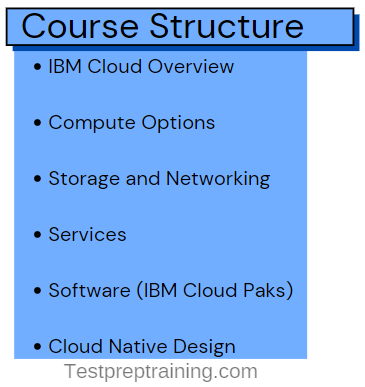
Section 1 – IBM Cloud Overview
1.1. Understanding the types of Cloud deployment options.
1.1.1. Describing a Public Cloud. (IBM Reference: Public Cloud)
1.1.2. Explaining a Private Cloud. (IBM Reference: IBM Cloud Private)
1.1.3. Describing a Hybrid Cloud. (IBM Reference: Hybrid Cloud)
- Multi-Cloud
1.2. Explaining the difference between SaaS, PaaS and IaaS.
IBM Reference: IaaS, PaaS and SaaS – IBM Cloud service models
1.2.1. Explaining the benefits of using IaaS.
1.2.2. Describing the usage of IaaS.
- Server
- Storage
- Networking
1.2.3. Explaining the benefits of using SaaS.
1.2.4. Describing the usage of SaaS.
- Subscription model
1.2.5. Explaining the benefits of using PaaS.
1.2.6. Describing the usage of PaaS.
1.3. Understanding the different IBM Cloud Account Types.
IBM Reference: Account types
1.3.1. Identifying the different IBM Cloud account types.
- Lite
- Pay-As-You-Go
- Subscription
1.3.2. Explaining how accounts are charged.
1.3.3. Applying promo codes.
1.3.4. Setting spending notifications.
1.4. Understanding how to use the cost estimator tool.
IBM Reference: Estimating your costs, Manage All Your Cloud Resources on the Enhanced IBM Cloud Platform
1.4.1. Understanding the features of the cost estimator tool.
1.4.2. Learning the export options of the cost estimator tool.
1.5. Understanding the benefits of the IBM Multi Cloud strategy.
IBM Reference: Multicloud, Understanding IBM’s Hybrid and Multicloud Strategy, IBM Cloud Pak for Multicloud Management
1.5.1. Explaining a Single Cloud Environment.
1.5.2. Explaining a Multi Cloud Environment.
1.5.3 Discussing benefits of Single or Multi Cloud.
1.6. Understanding IBM Cloud Support Plans.
IBM Reference: Basic, Advanced, and Premium Support plans, IBM Cloud Support
1.6.1. Opening a support ticket.
1.6.2. Discussing different types of Support plans.
1.6.3. Discuss other Free support resources and communities.
- IBM Cloud docs
- IBM Developer community
- Github community
- Stack overflow
1.7. Explain the benefits of Availability Zones.
IBM Reference: Why Deploy Applications on IBM Cloud Availability Zones, What Services Can You Expect in IBM Cloud Availability Zones
1.7.1. Understanding the IBM Availability Zones.
1.7.2. Learning Single Zone Regions (SZR).
1.7.3. Understanding Multi-Zone Regions (MZR).
1.7.4. Describing the benefits of deploying applications on IBM Cloud Availability Zones.
1.8. Understanding the international compliance standards that are used by IBM Cloud.
IBM Reference: IBM Cloud compliance programs
1.8.1. Explaining Global standards.
- CSA
- ISO
- SOC
1.8.2. Explaining US Federal Governments standards.
- FedRAMP
- ITAR
1.8.3. Explaining Industry standards.
- HIPAA
- PCI
1.8.4. Explaining Regional Standards.
- GDPR/DSGVO
1.9. Explaining the features and benefits of Identity and Access Management (IAM).
1.9.1. Identifying the purpose for Cloud Identity and Access Management). (IBM Reference: IBM Cloud Identity and Access Management)
1.9.2. Understanding IAM concepts.
(IBM Reference: IBM Cloud Identity and Access Management, Access management in IBM Cloud)
- Subjects
- Access groups
- Targets
- Resource groups
- Roles
- Actions
- Policies
1.9.3. Demonstrating an understanding of best practices for assigning access to cloud resources. (IBM Reference: Best practices for organizing resources and assigning access)
1.9.4. Identifying cloud resources that are not secured by IAM. (IBM Reference: Access management in IBM Cloud)
Section 2 – Compute Options
2.1. Understanding the benefits and options of Classic Infrastructure.
IBM Reference: Getting started with IBM Power Systems Virtual Servers, Getting started with virtual servers
2.1.1. Describe the different virtual server offerings.
- IBM Virtual Servers
- Virtual Servers on Power
- HyperProtect Virtual Servers
2.1.2. Describing the benefits of each offering.
- Cost
- Performance
- Security
2.1.3. Describing the different types of Virtual Servers.
- Public
- Dedicated
- Transient
- Reserved
2.1.4. Identifying the key Operating Systems supported for each Virtual Server Type.
2.1.5. Identifying the key billing options.
- Hourly
- Monthly
2.1.6. Describing the different configuration options for Bare Metal Servers.
IBM Reference: Bare metal server options
- CPU-Type, Memory, and GPU
2.1.7. Describing the key benefits of bare metal servers.
- Performance
- Security
2.1.8. Identifying the Operating System choices for Bare Metal Server.
2.1.9. Identifying the different billing options.
- Hourly, Monthly, etc…
2.2. Understanding the benefits and options for IBM Kubernetes Service.
IBM Reference: Getting started with IBM Cloud Kubernetes Service, Improving App Availability with Multizone Clusters
2.2.1. Describing the three main components of the IBM Kubernetes Service (IKS).
- IBM Kubernetes Service cluster
- IBM Kubernetes Service registry
- Helm Catalog
2.2.2. Describing the advantages of using IKS.
- Rapid Deployment
- Managed Environment
- Secured Environment
2.2.3. Identifying the node types that are provisioned and accessible by the users.
- Worker Nodes only
2.2.4. Identifying The different plan types for IKS.
- Free and Standard/Hourly
2.2.5. Identifying the three types provided by IKS.
- Virtual Shared
- Virtual Dedicated
- Bare Metal
2.2.6. Describing the Availability Zone options for IKS.
- Multi-zone cluster
- Single zone cluster
2.3. Understanding the benefits and options for IBM Red Hat OpenShift.
IBM Reference: Getting started with Red Hat OpenShift on IBM Cloud
2.3.1. Describing the key benefits of IBM Red Hat OpenShift (ROKS).
- Ease of Deployment
- Managed Environment
2.3.2. What key options are available for ROKS.
- Memory
- CPU
- Storage
- Number of worker nodes
2.3.3. Identifying the node types that are provisioned and accessible by the users.
- Worker Nodes only
2.3.4. Identifying the different plan types for ROKS.
- Free and Standard/Hourly
2.3.5. Identifying the three types provided by ROKS.
- Virtual Shared
- Virtual Dedicated
- Bare Metal
2.3.6. Describing the Availability Zone options for ROKS.
- Multi-zone cluster
- Single zone cluster
2.4. Understanding the benefits and options for IBM Virtual Private Cloud (Gen 1 & Gen 2).
IBM Reference: Getting started with Virtual Private Cloud (Gen 1 compute), IBM Cloud Virtual Private Cloud
2.4.1. Describing the key features of IBM Virtual Private Cloud (VPC).
2.4.2. Describing the key differences between Gen 1 and Gen 2.
- Improved network performance up to 80Gbps (Gen 2)
- Faster provisioning times (Gen 2)
2.4.3. Identifying the key components of VPC.
- VPC instance
- Multiple subnets
- User controlled security and security groups
- Virtual Server Instances
- Gateway service
- VPN Service to connect as an extension to client’s data center
- Block Storage Volumes
2.5. Understanding the benefits and options for IBM VMware Solutions.
IBM Reference: Getting started with IBM Cloud for VMware Solutions
2.5.1. Describing the different VMware Solution Options on IBM Cloud.
- VCenter
- vSphere
2.5.2. Describing the key differences between the VMware vCenter and vSphere offerings.
2.5.3. Describing the two VMware vCenter offerings and how they differ.
- VMware vCenter
- VMware vCenter with NSX-T
2.5.4. Describing the different Optional Services Categories.
- Security and Compliance
- Business Continuity and Migration
- Transformation and Modernization of VMware Applications
- Management Tools
2.6. Understanding the benefits and options for IBM Cloud Foundry.
IBM Reference: Cloud Foundry Overview
2.6.1. Describing the main advantage of the IBM Cloud Foundry offering.
- Managed environment
2.6.2. Describing the two main IBM Cloud Foundry offerings.
- Public Applications
- Enterprise Environment
2.6.3. Describing the key differences between the two Cloud Foundry offerings.
- Public Application is a multi-tenant environment
- The enterprise environment is an isolated single-tenant (dedicated) environment
Section 3 – Storage and Networking
3.1. Understanding the benefits and options of IBM File Storage.
IBM Reference: File Storage, Overview of File Storage
3.1.1. Distinguishing features and functionality provided by IBM File Storage.
3.1.2. Distinguishing integration possibilities of IBM File Storage.
- Reconciling between various product offerings to construct an appropriate solution that will satisfy customer requirements
- Determining characteristics of IBM File Storage
3.1.3. Utilizing accepted tools and methodologies to determine appropriate architecture.
- Remote access
3.2. Understanding the benefits and options of IBM Block Storage.
IBM Reference: Block Storage, Overview of Block Storage
3.2.1. Distinguishing features and functionality provided by IBM Block Storage.
3.2.2. Distinguishing integration possibilities of IBM Block Storage.
- Evaluating between various product offerings to construct an appropriate solution that will satisfy customer requirements
- Determining characteristics of IBM Block Storage
3.2.3. Utilizing accepted tools and methodologies to determine appropriate architecture.
- Remote access
3.3. Understanding the benefits and options of IBM Cloud Object Storage.
IBM Reference: About IBM Cloud Object Storage (Classic), Getting started with IBM Cloud Object Storage, IBM Cloud Object Storage
3.3.1. Distinguishing features and functionality provided by IBM Cloud Object Storage.
3.3.2. Distinguishing integration possibilities of IBM Cloud Object Storage.
- Evaluating and reconciling between various product offerings to construct an appropriate solution that will satisfy customer requirements
- Determining characteristics of IBM Cloud Object Storage
3.3.3. Utilizing accepted tools and methodologies to determine appropriate architecture.
- Remote access
3.4. Understanding the benefits and options of IBM Backup, Recovery and Replication Solutions.
IBM Reference: Backup and Restore, Getting started with IBM Cloud Backup, Zerto overview, Veeam v9.5 overview
3.4.1. Distinguishing features and functionality provided in IBM Cloud Environments.
3.4.2. Distinguishing integration possibilities of IBM Backup, Recovery & Replication Solutions.
3.4.3. Utilizing accepted tools and methodologies to determine appropriate architecture.
- Remote access
3.5. Understanding the benefits and options of IBM Cloud Networking.
IBM Reference: IBM Cloud Load Balancer, IPSec VPN, Secure Gateway Service, Getting started with IBM Cloud Direct Link (2.0)
3.5.1. Understanding network components.
- load balancers, firewalls, dns services, etc
3.5.2. Explaining features and functionality provided by IBM.
3.5.3. Distinguishing integration possibilities of IPSEC VPN Solutions.
3.5.4. Distinguishing integration possibilities of Networking Options.
3.5.5. Articulating the value proposition of Load Balancer solutions.
3.5.6. Utilizing accepted tools and methodologies to determine appropriate architecture.
3.5.7. Understanding how to integrate with on-premise resources from the Cloud.
3.5.8. Understanding how to integrate from the Cloud to on-premise.
- CIS
- Direct Link
- Secure Gateway
Section 4 – Services
4.1. Understanding the different Application Integration options on IBM Cloud.
4.1.1. Distinguishing functionality provided by API Connect and API Gateway.
IBM Reference: IBM Cloud API Gateway, IBM API Connect
- When/why would one use API Connect
- when/why would one use API Gateway
4.1.2. Distinguishing functionality provided by App-Connect, Event Streams, and MQ.
IBM Reference: App Connect concepts, Event Streams, Introduction to IBM MQ
- When/why would one use App Connect
- When/why would one use Event Streams
- Why/when would one use MQ
4.2. Explaining how the Internet of Things (IoT) can be leveraged within IBM Cloud.
4.2.1. Listing and describing the features/capabilities provided by the Watson IoT Platform.
IBM Reference: Internet of Things Platform, Product architecture
- Connect
- Information Management
- Analyze in real-time
- Risk and Security Management
4.2.2. Identifying the general scenario/use case where the IoT Platform should be leveraged. (IBM Reference: Product architecture)
4.2.3. Listing and describing the features/capabilities provided by Mobile Foundation. (IBM Reference: Mobile Foundation)
4.2.4. Distinguishing the features/capabilities of Push Notifications vs. Mobile Foundation.
IBM Reference: Push Notifications, Mobile Foundation
- When/why would one use Push Notifications
- When/why would one use Mobile Foundation
4.2.5. Describing the use of AppID for mobile development. (IBM Reference: About App ID)
4.3. Describing the value of Blockchain.
4.3.1. List/Identifying Blockchain functionality. (IBM Reference: blockchain technology)
4.3.2. Describing the purpose for smart contracts. (IBM Reference: blockchain technology)
4.3.3. Explaining the business value of blockchain. (IBM Reference: Building your blockchain advantage)
4.4. Explaining how DevOps is implemented in IBM Cloud and OpenShift.
4.4.1. Defining DevOps. (IBM Reference: DevOps)
4.4.2. Describing the business value of DevOps. (IBM Reference: IBM DevOps, DevOps)
4.4.3. Distinguishing continuous integration, continuous delivery and continuous deployment. (IBM Reference: DevOps)
4.4.4. Summarizing the capabilities of a toolchain. (IBM Reference: DevOps toolchains)
4.4.5. Demonstrating how to apply different toolchains to support the DevOps needs of different application scenarios.
IBM Reference: IBM Cloud Continuous Delivery: Build, deploy, and manage apps with toolchains
- Canary testing
- Different Kubernetes applications
- Kubernetes vs. Cloud Foundry
- IBM Cloud Continuous Delivery
4.4.6. Identify/List stages supported by Red Hat OpenShift DevOps.
4.5. Understanding the benefits and capabilities of adding AI into applications.
4.5.1. Defining Data Science and Machine Learning. (IBM Reference: Data science)
4.5.2. Explaining the value of Data Science to businesses. (IBM Reference: Data science)
4.5.3. Defining Machine Learning. IBM Reference: Data science and machine learning)
4.5.4. Describing the functionality provided by different types of Machine Learning/Knowledge Management services
IBM Reference: IBM Watson Discovery, IBM Watson Knowledge Studio, Overview: Watson Machine Learning, IBM Watson Natural Language Classifier, Watson OpenScale
- Watson Studio, Discovery, Knowledge Catalog, Knowledge Studio, Machine Learning, Natural Language Classifier, Watson OpenScale
4.5.5. Choosing speech, text, and/or language translation services to implement different business use cases. (IBM Reference: Speech to Text, Text to Speech, Language Translator, IBM Watson Personality Insights service, IBM Watson Tone Analyzer service)
4.6. Understanding the different analytics options.
4.6.1. Listing the functionality provided by different types of analytics technologies.
IBM Reference: Apache Spark, Big Data and Hadoop on IBM Cloud, IBM Streams
- Spark, Hadoop, Streaming
4.6.2. Distinguishing the functionality provided by different analytic services available on IBM Cloud.
- Analytics Engine (IBM Reference: IBM Analytics Engine overview)
- Db2 Warehouse (IBM Reference: IBM Db2 Warehouse, Analyzing your data)
- IBM Cognos Dashboard Embedded (IBM Reference: Overview of Cognos Dashboard Embedded)
- Streaming Analytics (IBM Reference: About Streaming Analytics)
4.7. Understanding the different Database options.
4.7.1. Describing the functionality provided by different types of database technologies.
IBM Reference: Overview of the Database Landscape, Relational Databases, NoSQL Databases
- Relational/SQL, document stores, key-value, graph, data warehouses, etc.
4.7.2. Distinguishing the functionality provided by different databases available on IBM Cloud.
IBM Reference: Cloud databases on IBM Cloud
- When/why use the different database options
- Document
- Relational
- Key-Value
4.7.3. Articulating entry point use cases for migrating Customer DBs to IBM Cloud
4.8. Understanding the benefits and options of IBM Hyper Protect Crypto services.
IBM Reference: Getting started with IBM Cloud Hyper Protect Crypto Services
4.8.1. Explaining IBM HyperProtect Crypto Services.
4.8.2. Understanding how customers can bring their own keys for a managed encryption solution.
4.9. Understanding the benefits and options of IBM Hyper Protect DB as a Service (DBaaS).
IBM Reference: Hyper Protect DBaaS for MongoDB, Hyper Protect DBaaS for PostgreSQL
4.9.1. Explaining IBM HyperProtect DBaaS.
4.9.2. Identifying which databases are supported.
Section 5 – Software (IBM Cloud Paks)
5.1. Understanding the benefits and capabilities of IBM Cloud Paks.
IBM Reference: IBM Cloud Paks, Overview of IBM Cloud Paks, IBM Cloud Pak solutions, IBM Cloud Pak System, IBM Cloud Pak for Data: Deployments
5.1.1. Describing the role of Cloud Paks to accelerate journey to Cloud.
- What’s preventing 80% of the workload from moving to the Cloud?
- Journey to Cloud (Migrate, Modernize, Build and Manage)
- Partnership between IBM and Red Hat on the Cloud Paks
5.1.2. Identifying the value of using IBM Cloud Paks.
- Complete, yet simple
- IBM Certified
- Run anywhere
5.1.3. Identifying the deployment options of the Cloud Paks.
5.1.4. Identifying the Container Platform that Cloud Paks are based on.
5.1.5. Describing IBM Cloud Pak System and its value proposition.
5.1.6. Identifying the value of running IBM Cloud Paks on IBM Cloud.
5.2. Understanding the benefits and capabilities of the IBM Cloud Pak Solutions.
5.2.1. Knowing the benefits of IBM Cloud Pak for Apps. (IBM Reference: IBM Cloud Pak for Applications)
5.2.2. Understanding the benefits of IBM Cloud Pak for Integration. (IBM Reference: IBM Cloud Pak for Integration)
5.2.3. Learning about the benefits of IBM Cloud Pak for Automation. (IBM Reference: IBM Cloud Pak for Automation)
5.2.4. Learning about the benefits of IBM Cloud Pak for Multi Cloud Management. (IBM Reference: IBM Cloud Pak for Multicloud Management)
5.2.5. Understanding the benefits of IBM Cloud Pak for Data. (IBM Reference: IBM Cloud Pak for Data)
5.2.6. Understanding the benefits of IBM Cloud Pak for Security. (IBM Reference: IBM Cloud Pak for Security)
Section 6 – Cloud Native Design
6.1. Describing the different elements of the IBM Cloud Garage Method.
IBM Reference: IBM Garage Methodology, IBM Garage Method for Cloud
6.1.1. Giving a high-level overview of IBM Cloud Garage Method.
6.1.2. Knowing about the various practices in IBM Cloud Garage Method.
6.1.3. Knowing about how to arrange a Garage Visit.
6.2. Describe the benefits of Cloud Native design.
IBM Reference: Cloud Native Applications
6.2.1. Explaining what is meant by Cloud Native
6.2.2. Articulating the benefits of Cloud Native Design
6.2.3. Knowing about Microservices principles
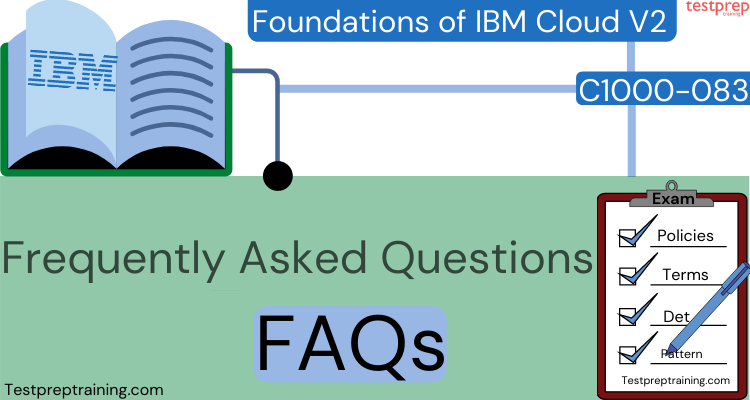
For More Visit: Foundation of IBM Cloud V2 (C1000-083) Exam FAQs
Exam Policies
IBM Certifications are valuable credentials and it is our duty for maintaining the integrity and security of IBM certification. Thus, IBM offers various exam policies aimed at protecting investment and the integrity of the program. Some of them are:
IBM Test Retake Policy
The exam retake policy states the same certification test can only be taken two times within a 30 day period. However, if a certification exam is not completed on the first attempt then, there is no requirement to wait before taking the test again. And, the candidates should not take the same test more than twice within any 30 days. If candidates pass the exam then, retakes are not allowed.
Testing Policies
A violation of IBM testing policy can result in the revocation of certification and suspension from the IBM Professional Certification Program. The content of each IBM exam is the property of IBM Corporation. The test content is proprietary and confidential and may not be reproduced or disclosed.
Preparation Guide for IBM C1000-083 Exam
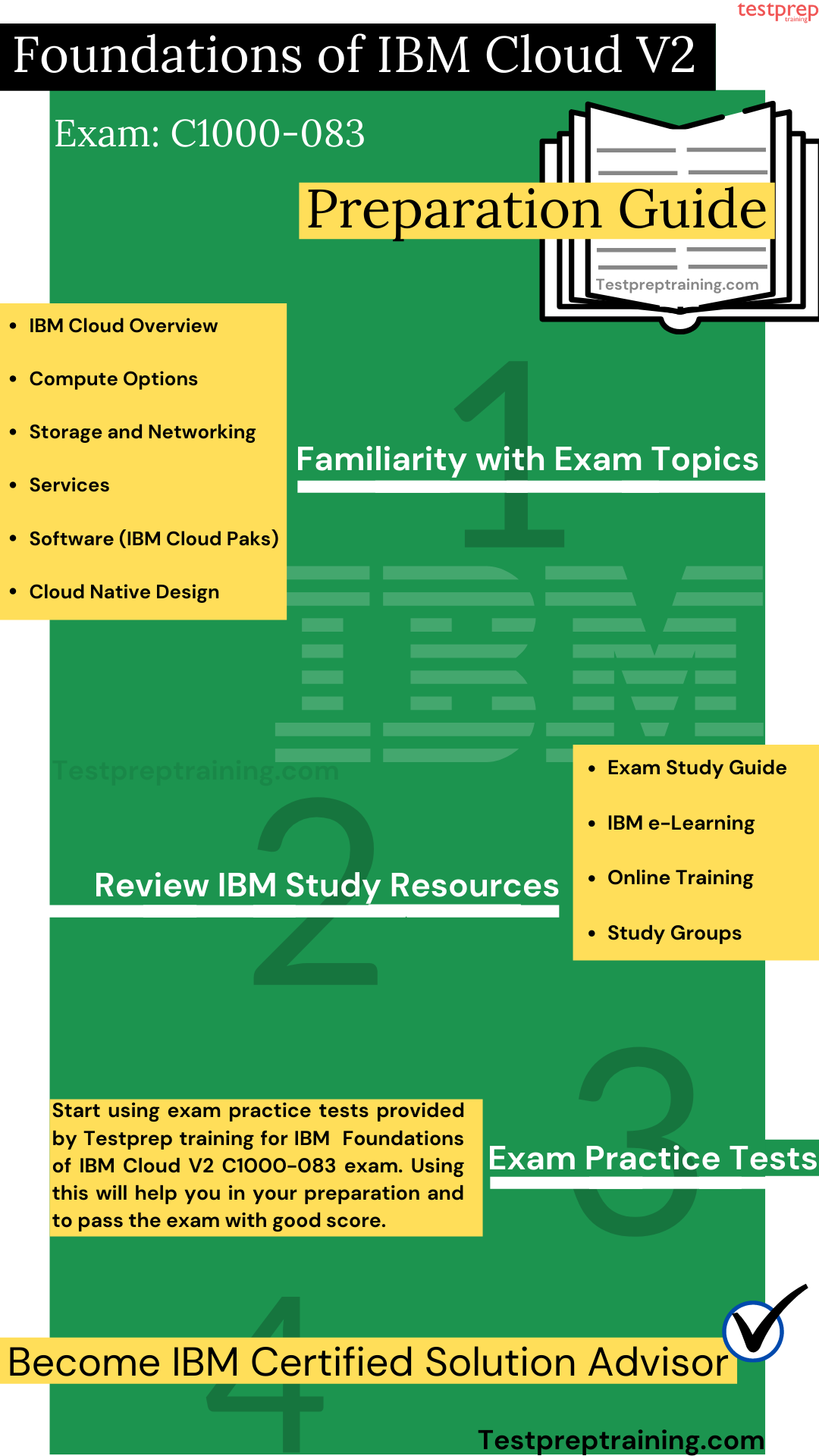
IBM C1000-083 Study Guide
IBM provides candidate’s exam study guide to help prepare for the IBM C1000-083 exam. This study guide explains all the tasks and knowledge that an individual would need to have in order to successfully implement the product. Moreover, this includes various exam objectives with provided references that will help candidates to understand the concepts more accurately.
IBM e-Learning
IBM Cloud Essentials
In the e-Learning section of IBM, candidates can have access to the Cloud Essential course that introduces to the IBM Cloud. In this, candidates will learn about the various services IBM Cloud has to deliver enterprise capabilities for private, public, hybrid, and multi-cloud. Moreover, it will help candidates to know about the various services models available on the IBM Cloud, from the infrastructure pieces to the platform capabilities.
Online Training
Introduction to Cloud
In this course, candidates will get the basic knowledge and understanding of the core concepts of cloud computing. Moreover, they will gain the foundational knowledge required for understanding cloud computing from both business and practitioner perspectives. This will also help them to learn about the definition and essential characteristics of cloud computing and the business case for cloud computing. In addition, it will help them to understand about the various cloud service models (IaaS, PaaS, SaaS) and deployment models (Public Cloud, Private Cloud, Hybrid Cloud) and the key components of a cloud architecture (Virtualization, VMs, Storage, Networking, Containers, Serverless).
Online Study Groups
One thing that will be beneficial during the exam preparation time is to join study groups. As these groups will help you to stay connected with the other people who are on the same pathway as yours. Moreover, here you can start any discussion about the issue related to the exam or any query. By doing so, you will get the best possible answer to your query.
IBM C1000-083 Practice Test
This can be a very essential part that can help you to prepare better for the exam. That is to say, practice tests are important as by assessing yourself with these tests you will know about your weak and strong areas. However, by practicing you will be able to improve your answering skills that will result in saving a lot of time. Moreover, the best way to start doing IBM C1000-083 Sample Test is after completing one full topic as this will work as a revision part for you. So, make sure to find the best practice sources.

